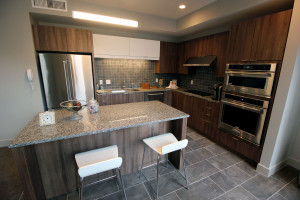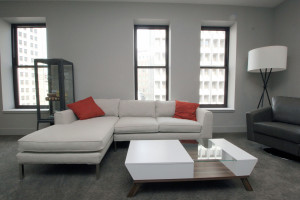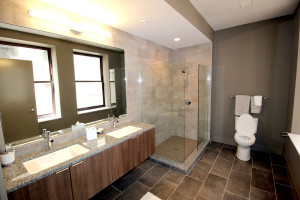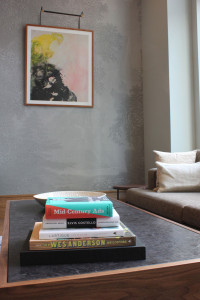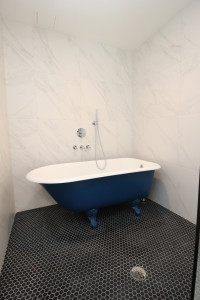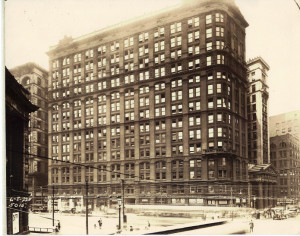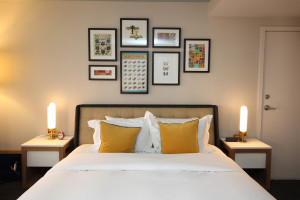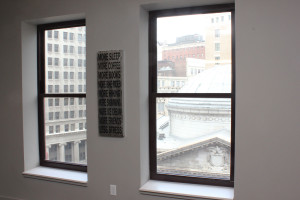After a long wait and a lot of work, the Kimpton Schofield in downtown Cleveland effortlessly blends home and hotel
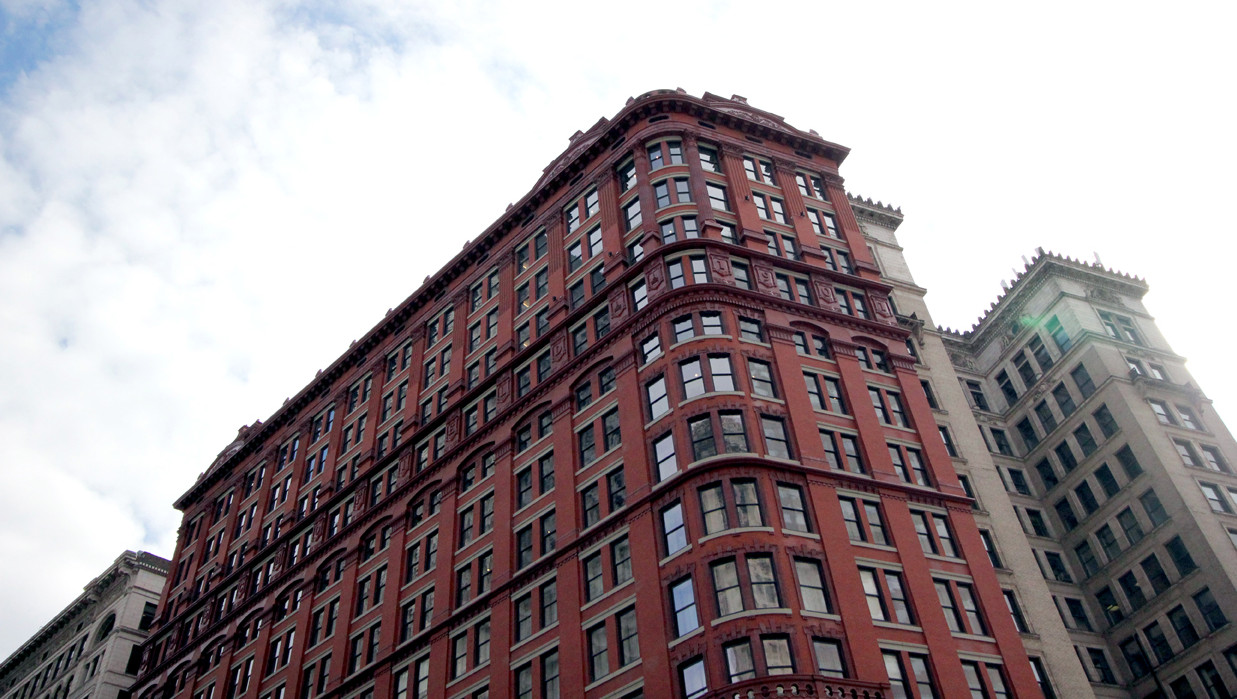
Story by Carlo Wolff
Photography by Michael C. Butz
All cleaned up and ready to go, the Kimpton Schofield is a ruddy beauty, a striking blend of the sturdy and the stylish, the classic and the contemporary.
Its terra cotta details lovingly restored, its entranceway inviting, and with a full-service restaurant little more than a month away, Cleveland’s first Kimpton hotel and the 52 luxury apartments known as The Schofield Residences look and feel solid. They’re also anything but stodgy. The hotel is the first seven floors, the Residences floors eight to 14.
Visit a Schofield Residence and note the many elegantly framed and recessed windows offering views of downtown Cleveland. The bathroom and living room are long and smooth and relaxing, their palettes muted, long on dove grey and earth brown. A Residence is an ideal place to showcase one’s own furnishings and accessories, from functional and whimsical furniture to bright bedroom accents.
Stroll a corner suite, one of the 122 hotel units, for its distinctive décor and those hints of eccentricity that make Kimpton hotels so boutique.
Note the local touches in the hotel, like bedroom wall hangings featuring vintage matchbooks from Cleveland’s past. The herringbone pattern on the lobby floor and the argyle pattern on some hallway carpeting reference the city’s storied garment industry. Hotel guests push pins identifying their homes into a map of the world on a wall across from check-in.
One reason Kimpton was chosen to operate its first Ohio outpost is it strives to do more than align with local culture. It incorporates and celebrates it, according to Marcie Gilmore, leasing consultant for The Schofield Residences and manager of the hotel.
Residences lease for $1,395 (one bedroom) to $7,250 (three bedrooms) a month, depending on size. There are 38 one-bedroom, 11 two-bedroom and three three-bedroom residences.
Oh, yes. There are loaner guitars and loaner bicycles, and the building is pet-friendly, a mark of Kimpton properties for more than 25 years. And hotel amenities and full concierge services are available to Residences occupants.
Such touches and that reciprocity add up in a mixed-use structure – retail is part of the plan – in which the permanent mingles with the transient.
The Schofield Residences opened March 1, the Kimpton a week later. Fresh from a $50 million renovation, the 172-foot, 14-story building is already among the most cosmopolitan in an increasingly urbane downtown.
- Modern designs rule the kitchen.
- Modern designs rule the living room of The Schofield Residences.
- The bathroom in The Schofield Residences.
Fitting in
Built in 1902 by the architect Levi Scofield, who stamped the East 9th landmark with “Schofield” before he changed the spelling of his name to remove the “H,” this Romanesque, late-Victorian beauty of steel frame construction wraps around the northwest corner of East 9th and Euclid Avenue, catty corner from the former Huntington Building. Rebranded the 925 Building, the former Huntington is being renovated by Andrew “Avi” Greenbaum, a Florida-based entrepreneur.
Other close neighbors of the Schofield building are Heinen’s of Downtown Cleveland and The 9 complex.
It’s a short walk down Euclid to East Fourth Street or up East 9th to the Rock Hall. It’s similarly close to Playhouse Square. You can gaze down on the cupola that caps the Heinen’s if you’re in the right Residence. Consider it Cleveland Central.
As Gilmore puts it, the Schofield building is at the “corner of Main and Main.”
In addition to the hotel and the residences, she points out, there’s a 2,500-square-foot vacant retail space at that corner – at ground level. And a 4,700-square-foot, two-story restaurant, Parker’s Downtown, is scheduled to open there in May.
- Hotel lobby
- The rooms feature lighted signs that allow visitors to change the greeting or message.
Building blocks
“It’s unusual for a building to be named after its architect,” says Jack Bialosky, principal at Bialosky + Partners Architects, one of three Cleveland architectural firms involved in the complicated, long-gestating project. (The others are Studio CRM, the design branch of building owner CRM Companies, and Sandvick Architects.)
Scofield was a noted Cleveland architect who also designed the Cleveland Soldiers’ and Sailors’ Monument on Public Square.
Bialosky and his firm’s Ted Ferringer, the project architect, noted the Schofield building has been through several lives. Until 2009, when renovation plans began to take shape and it emptied out in anticipation, it primarily was used for offices.
Besides Bialosky and Ferringer, the Bialosky team working on the Kimpton Schofield included Paul Deutsch, principal in charge, and Ryan Parsons, project manager.
“In point of fact, it’s been a very complex project with a very large team,” says Bialosky, noting the degree of deterioration, the complexity of the infrastructure and challenges in putting together financing contributed to its protracted development.
And, of course, there was the recession of 2008, making funding even more problematic.
The first order of business was removing the fiberglass cladding that a former Bialosky associate had installed in the 1960s. The removal essentially uncovered a structure that hadn’t been seen for years, revealing a badly deteriorated building with a distinctive, if damaged, terra cotta façade.
“The majority of the systems – the mechanicals, the HVAC – had outspent their useful lifespan,” says Ferringer.
“I think it’s probably the most complex adaptive reuse and historic restoration project that’s taken place in downtown Cleveland in some time, if not ever. One of the reasons construction took so long was the painstaking recreation and restoration of the building façade,” he added. Other factors were replacement of the heating and air-conditioning systems and the building itself “had to be restored, which meant replacing a big portion of it.”
“Remember that this is starting right at the time of the Great Recession,” Bialosky adds. “The number of moving parts is what made it so difficult.” The owner, CRM, had to juggle the restoration of the building and its infrastructure even as it put together a financing package and settled on a hotel operator, he says. Kimpton got the nod in 2012.
Construction couldn’t start until a financing package including state and federal historic tax credits – justified by removal of that 1960s cladding – was assembled and a hotel operator chosen.
- The Kimpton Schofield in 1922. (PHOTO | Bialosky + Partners Architects)
- Catching design and decorations in the hotel suite.
- The view from this Schofield Residences unit’s kitchen looks down onto the intersection of East 9th Street and Euclid Avenue.
The work
“The first step was removing that curtain wall, seeing what was left, and being able to demonstrate to the state preservation office that the building could be contributing to the historic district again,” says Jeffrey Smith, principal, Studio CRM. “Then we had to go through that approval process.”
Studio CRM was lead design architect and architect of record for the building’s interiors and coordinated the consultant team for the whole project.
Meanwhile, CRM Companies had to put together the financing. Once the $50 million renovation had tax credits assigned to it, a result of being able to prove it could be a contributing historic building again, the balance came from private investment. By 2011, removal of the facade and demolition of the interior were well underway. The building was essentially gutted, down to the central staircase.
Meanwhile, dialogue with San Francisco-based Kimpton, the original boutique hotel company, quickened; it started in 2009, Smith noted, adding several hotel operators were evaluated, “and Kimpton was chosen as the right fit because of its experience with historic properties and the qualities and challenges of historic properties,” as well as “the boutique hotel culture it offered.”
Another key consideration was the floor plate, or rentable footprint, Smith says, noting the building was typical of its time in its number of light wells, vertical shafts that let in outside light. But the F-shaped floor plates were unusual, and more suitable for hotel and residential use than for modern office use, he says.
“We’re very happy with the way it turned out and we’re happy with the way it’s been received,” he says. “The goal was to create interiors that are as warm and inviting as the exterior of the building, but done in a modern way.” js

